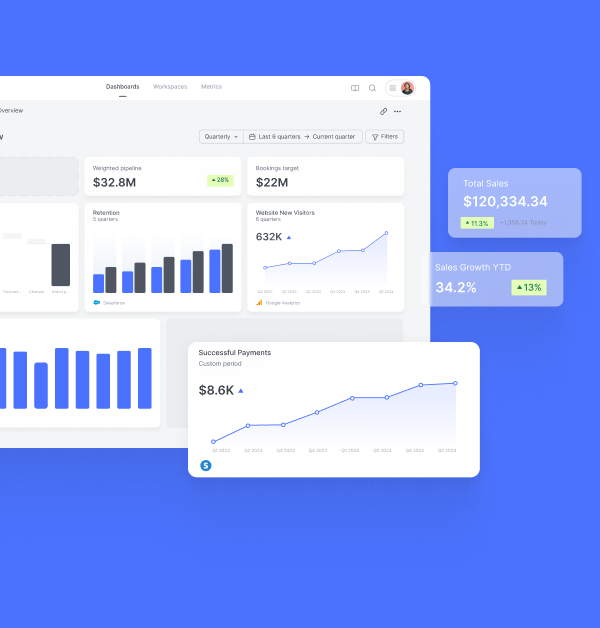MQL Velocity
Business questions
- How long does it take MQLs to convert to SALs, Opportunities or Customers?
- What segments, sources or regions have the highest or lowest MQL velocity?
- How has our MQL velocity changed over time?
Included Metrics (2)
MQL Velocity template description
Why you should use the MQL Velocity template
Analyzing the velocity of marketing qualified leads (MQLs) through the lead funnel is crucial for optimizing your marketing and sales processes. The MQL Velocity template provides detailed insights into the time it takes for MQLs to become sales accepted leads (SALs) and opportunities, helping you to identify and enhance the most efficient paths through your funnel.
- Monitor Efficiency: Track how quickly leads move through the funnel to optimize conversion rates.
- Identify Bottlenecks: Pinpoint stages where leads are delayed, enabling targeted improvements.
- Enhance Strategies: Use velocity insights to refine marketing and sales strategies, improving overall performance.
- Improve Reporting: Generate precise and up-to-date reports on MQL velocity without manual effort.
Who is this template for
- Marketing Managers: Monitor the effectiveness of marketing campaigns in generating fast-converting leads.
- Sales Managers: Identify and optimize stages where leads may be getting delayed.
- RevOps Analysts: Analyze and improve the lead conversion process to support strategic planning.
Key Benefits
- Detailed Tracking: Monitor the average number of days from MQL to SAL and opportunity.
- Source and Segment Insights: Identify the most efficient sources, segments, and lead roles for faster conversions.
- Trend Analysis: Understand how MQL velocity changes over time to adjust strategies accordingly.
- Enhanced Efficiency: Optimize your marketing and sales processes based on data-driven insights.
How does this Template work?
The MQL Velocity template tracks the average number of days it takes for leads to progress from MQL to SAL and from MQL to opportunity. By analyzing this data, you can identify the most efficient lead sources, segments, and roles, as well as pinpoint bottlenecks in the conversion process. This comprehensive view enables you to optimize your lead funnel and improve overall conversion rates.
Frequently Asked Questions
How is MQL velocity calculated?
MQL velocity is calculated by tracking the average number of days it takes for leads to move from MQL to SAL and from MQL to opportunity.
Can I analyze velocity by different dimensions?
Yes. The template allows you to break down MQL velocity by lead source, segment, and role, providing detailed insights into various aspects of your lead funnel.
How often is the data updated?
The data is updated in real-time, ensuring that your MQL velocity reports are always accurate and current.
How can this template help improve our conversion rates?
By providing detailed insights into the speed of lead conversion, this template helps you identify efficient paths and bottlenecks, enabling you to refine your strategies and improve overall conversion rates.
Why you should use the MQL Velocity template
Analyzing the velocity of marketing qualified leads (MQLs) through the lead funnel is crucial for optimizing your marketing and sales processes. The MQL Velocity template provides detailed insights into the time it takes for MQLs to become sales accepted leads (SALs) and opportunities, helping you to identify and enhance the most efficient paths through your funnel.
- Monitor Efficiency: Track how quickly leads move through the funnel to optimize conversion rates.
- Identify Bottlenecks: Pinpoint stages where leads are delayed, enabling targeted improvements.
- Enhance Strategies: Use velocity insights to refine marketing and sales strategies, improving overall performance.
- Improve Reporting: Generate precise and up-to-date reports on MQL velocity without manual effort.
Who is this template for
- Marketing Managers: Monitor the effectiveness of marketing campaigns in generating fast-converting leads.
- Sales Managers: Identify and optimize stages where leads may be getting delayed.
- RevOps Analysts: Analyze and improve the lead conversion process to support strategic planning.
Key Benefits
- Detailed Tracking: Monitor the average number of days from MQL to SAL and opportunity.
- Source and Segment Insights: Identify the most efficient sources, segments, and lead roles for faster conversions.
- Trend Analysis: Understand how MQL velocity changes over time to adjust strategies accordingly.
- Enhanced Efficiency: Optimize your marketing and sales processes based on data-driven insights.
How does this Template work?
The MQL Velocity template tracks the average number of days it takes for leads to progress from MQL to SAL and from MQL to opportunity. By analyzing this data, you can identify the most efficient lead sources, segments, and roles, as well as pinpoint bottlenecks in the conversion process. This comprehensive view enables you to optimize your lead funnel and improve overall conversion rates.
Frequently Asked Questions
How is MQL velocity calculated?
MQL velocity is calculated by tracking the average number of days it takes for leads to move from MQL to SAL and from MQL to opportunity.
Can I analyze velocity by different dimensions?
Yes. The template allows you to break down MQL velocity by lead source, segment, and role, providing detailed insights into various aspects of your lead funnel.
How often is the data updated?
The data is updated in real-time, ensuring that your MQL velocity reports are always accurate and current.
How can this template help improve our conversion rates?
By providing detailed insights into the speed of lead conversion, this template helps you identify efficient paths and bottlenecks, enabling you to refine your strategies and improve overall conversion rates.
How it works
Sightfull is your automated GTM analytics platform.
Low touch, quick deployment paired with automation ensures fast results across any interface of your choice.
